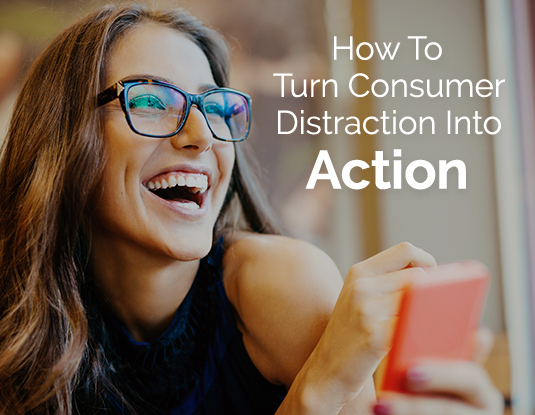deccatalkingpoints@decdesign.com
How To Turn Consumer Distraction Into Action

There are more ways to reach consumers than ever before. The downside? They’re harder to engage than ever. The onslaught of digital devices and the volume of content we view on them have created more choice. Mobile engagement takes up 60% of our time online and roughly 85% of that involves an app. With our ever-shrinking attention spans, this phenomenon is certain to accelerate. Now more than ever, marketers need to know just how to break through the clutter of digital advertising.
- The story behind the numbers.
Case in point, we use media and switch platforms more than ever before. Nielsen research reports that, over the last 13 years, we’ve increased our time spent with consumer media by nearly 45%. Meanwhile, another study shows we switch media platforms 17-27 times per hour, resulting in a 30% shorter attention span. Brand managers now have more opportunity to meet consumers, but not much time to engage them. - We think fast. We act fast.
Our brains react to the world in milliseconds, faster than we consciously recognize. It has more than 80 billion neurons, each one rapidly making 10,000-20,000 connections. As a result, much of what impacts our decisions—what we watch, talk about, and buy—isn’t our conscious thought process. Instead, it’s our instinctive, emotional responses that can’t be measured by traditional testing and research. - How should marketers address this?
Use a little neuroscience. The human brain processes and stores emotionally relevant information. What’s stored in our memory is most likely to influence our future behavior. In other words, we use emotions to guide us as we assess need, desire, value, and disinterest. Most of this process occurs below conscious awareness, so marketers can use this to their advantage without being obvious. - Neuromarketing is catching on.
Only a decade old, neuromarketing is still in its infancy. Still, excitement over its techniques is spreading. Some ad agencies specialize in neurotesting. Many big media companies are investing in brainwave researchers. Why? Because, unlike conventional focus-group studies that can run from $30,000 to $100,000, neuromarketing requires fewer subjects, is 100 percent objective, and costs far less to implement. - Consumer neuroscience goes even further.
It delivers insights that go much deeper than those derived from marketing surveys, focus groups, and social media feedback. It delivers non-conscious, unbiased, neurobiological-based responses. That’s helpful, because how we act often contradicts what we say. Finally, consumer neuroscience uses tools such as EEGs, biometrics, facial coding, implicit response testing, eye-tracking, and functional magnetic resonance that can capture the key ingredients of engagement—attention, emotion, and memory activation.
As humans, we like to think of ourselves as rational creatures who occasionally act emotionally. Modern neuroscience tells us the opposite is true—we’re emotional creatures who occasionally act rationally. Engaging the modern consumer means learning to create messages that evoke emotional responses. To paraphrase a famous poet, people will forget what you say and do, but they will never forget the way you make them feel.
Based on Advertising in the Age of Distraction by Carl Marci.
